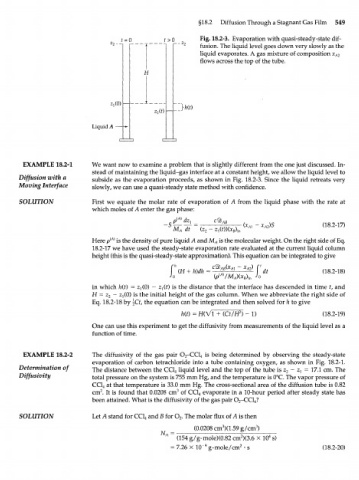Page 569 - Bird R.B. Transport phenomena
P. 569
§18.2 Diffusion Through a Stagnant Gas Film 549
t>0 Fig. 18.2-3. Evaporation with quasi-steady-state dif-
7 t
z 2 -- --z 2 fusion. The liquid level goes down very slowly as the
liquid evaporates. A gas mixture of composition x A2
flows across the top of the tube.
H
Liquid A
EXAMPLE 18.2-1 We want now to examine a problem that is slightly different from the one just discussed. In-
stead of maintaining the liquid-gas interface at a constant height, we allow the liquid level to
Diffusion with a subside as the evaporation proceeds, as shown in Fig. 18.2-3. Since the liquid retreats very
Moving Interface slowly, we can use a quasi-steady state method with confidence.
SOLUTION First we equate the molar rate of evaporation of A from the liquid phase with the rate at
which moles of A enter the gas phase:
- x A2 )S (18.2-17)
ix M
-
(z 2 z,(t))(x B ) ]n
Here p {A) is the density of pure liquid A and M A is the molecular weight. On the right side of Eq.
18.2-17 we have used the steady-state evaporation rate evaluated at the current liquid column
height (this is the quasi-steady-state approximation). This equation can be integrated to give
dt (18.2-18)
ш
(р /М А )(х в ) ]1Л
in which hit) = z^O) - z^it) is the distance that the interface has descended in time t, and
H = z 2 - ZT(0) is the initial height of the gas column. When we abbreviate the right side of
Eq. 18.2-18 by \Ct, the equation can be integrated and then solved for h to give
2
hit) = H(Vl + iCt/H ) - 1) (18.2-19)
One can use this experiment to get the diffusivity from measurements of the liquid level as a
function of time.
EXAMPLE 18.2-2 The diffusivity of the gas pair O -CC1 4 is being determined by observing the steady-state
2
evaporation of carbon tetrachloride into a tube containing oxygen, as shown in Fig. 18.2-1.
Determination of The distance between the CC1 liquid level and the top of the tube is z - z = 17Л cm. The
A
2
Diffusivity total pressure on the system is 4 755 mm Hg, and the temperature is 0°C. The vapor pressure of
CC1 at that temperature is 33.0 mm Hg. The cross-sectional area of the diffusion tube is 0.82
4
cm . 2 It is found that 0.0208 cm 3 of CC1 evaporate in a 10-hour period after steady state has
4
been attained. What is the diffusivity of the gas pair O -CC1 ?
2 4
SOLUTION Let A stand for CC1 and В for O . The molar flux of A is then
2
4
3
3
(0.0208 cm )(l.59 g/cm )
N. = (154 g/g-mole)(0.82 cm )(3.6 X 10 4 s)
2
A
9
= 7.26 X 10" g-mole/cm 2 • s (18.2-20)

